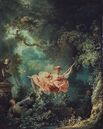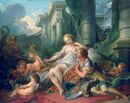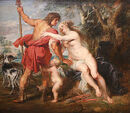No edit summary Tag: Visual edit |
No edit summary Tag: Visual edit |
||
| (8 intermediate revisions by 2 users not shown) | |||
| Line 1: | Line 1: | ||
{{Aesthetic|title1=Rococo|image1=The Swing.jpg|other_names=Late Baroque|key_colours=Pastel Colours|related_aesthetics=[[Baroque]]<br> |
{{Aesthetic|title1=Rococo|image1=The Swing.jpg|other_names=Late Baroque|key_colours=Pastel Colours|related_aesthetics=[[Baroque]]<br> |
||
[[Ethereal]]<br> |
[[Ethereal]]<br> |
||
| + | [[Lolita]]<br> |
||
| ⚫ | |||
| + | [[Princesscore]]<br> |
||
| ⚫ | |||
'''Rococo''', often called late [[Baroque]], was an architectural and artistic style developed in France in the first half of the eighteenth century. |
'''Rococo''', often called late [[Baroque]], was an architectural and artistic style developed in France in the first half of the eighteenth century. |
||
| Line 20: | Line 22: | ||
Rococo features exuberant decoration, with an abundance of curves, counter-curves, undulations and elements modeled on nature. The style was highly theatrical, designed to impress and awe at first sight. Floor plans of churches were often complex, featuring interlocking ovals; In palaces, grand stairways became centrepieces, and offered different points of view of the decoration. |
Rococo features exuberant decoration, with an abundance of curves, counter-curves, undulations and elements modeled on nature. The style was highly theatrical, designed to impress and awe at first sight. Floor plans of churches were often complex, featuring interlocking ovals; In palaces, grand stairways became centrepieces, and offered different points of view of the decoration. |
||
| − | The exteriors of Rococo buildings are often simple, while the interiors are entirely dominated by their ornament. The main ornaments of Rococo are: asymmetrical shells, acanthus and other leaves, birds, bouquets of flowers, fruits, musical instruments, angels and Far Eastern elements |
+ | The exteriors of Rococo buildings are often simple, while the interiors are entirely dominated by their ornament. The main ornaments of Rococo are: asymmetrical shells, acanthus and other leaves, birds, bouquets of flowers, fruits, musical instruments, angels and Far Eastern elements. |
| + | == Fashion == |
||
| + | Rococo fashion was based on extravagance, elegance, refinement and decoration. |
||
| + | |||
| + | === Men's Fashion === |
||
| + | |||
| + | ==== Suits ==== |
||
| + | |||
| + | * Habit à la française |
||
| + | |||
| + | ==== Accessories ==== |
||
| + | |||
| + | * Tricorne Hats |
||
| + | |||
| + | === Women's Fashion === |
||
| + | |||
| + | ==== Gowns ==== |
||
| + | |||
| + | * Brunswick |
||
| + | *Chemise à la reine |
||
| + | *Robe à l’anglaise |
||
| + | *Robe à la française |
||
| + | *Robe à la polonaise |
||
| + | |||
| + | ==== Footwear ==== |
||
| + | |||
| + | * Louis Heels |
||
| + | |||
| + | ==== Accessories ==== |
||
| + | |||
| + | *Fichu |
||
| + | *Gloves |
||
| + | * Hand Fans |
||
| + | |||
| + | ==== Jewelry ==== |
||
| + | |||
| + | *Cameos |
||
| + | *Diamond Bracelets |
||
| + | *Diamond Collars |
||
| + | *Diamond Earrings |
||
| + | *Lace Chokers |
||
| + | *Pearl Earrings |
||
| + | *Pearl Necklaces |
||
| + | |||
| + | <br /> |
||
== Gallery == |
== Gallery == |
||
<gallery widths="130"> |
<gallery widths="130"> |
||
| Line 33: | Line 79: | ||
Ba_roque.jpg |
Ba_roque.jpg |
||
</gallery> |
</gallery> |
||
| + | [[Category:History]] |
||
[[Category:Architecture]] |
[[Category:Architecture]] |
||
[[Category:Art]] |
[[Category:Art]] |
||
[[Category:Art movements]] |
[[Category:Art movements]] |
||
| + | [[Category:Visual]] |
||
| + | [[Category:Fashion]] |
||
[[Category:Needs work]] |
[[Category:Needs work]] |
||
Revision as of 12:07, 13 September 2021
Rococo, often called late Baroque, was an architectural and artistic style developed in France in the first half of the eighteenth century.
Rococo art rejected the dark solemnity of the Baroque aesthetic, while maintaining the ornamentation.
History
The Rococo style developed in France in the first half of the eighteenth century. The king of France, Louis XV is often thought to be a key patron and supporter of the movement-- a very likely hypothesis considering the monarch's need to differentiate himself from the king who proceeded him: Louis XIV (a key patron of the Baroque style).
Philosophy
Rococo styling brought about a new wave of romanticism; the new idea of finding a soulmate, someone whom you love, as opposed to the arranged marriages common in the past.
Visuals
The Rococo Period is known for its lighter and more airy tone, contrasting the heavy dark tone of the preceding Baroque era. It is characterized by its use of pastels and asymmetry, along with the repetitive use of symbols such as shell motifs, and an idealized version of nature.
Rococo features exuberant decoration, with an abundance of curves, counter-curves, undulations and elements modeled on nature. The style was highly theatrical, designed to impress and awe at first sight. Floor plans of churches were often complex, featuring interlocking ovals; In palaces, grand stairways became centrepieces, and offered different points of view of the decoration.
The exteriors of Rococo buildings are often simple, while the interiors are entirely dominated by their ornament. The main ornaments of Rococo are: asymmetrical shells, acanthus and other leaves, birds, bouquets of flowers, fruits, musical instruments, angels and Far Eastern elements.
Fashion
Rococo fashion was based on extravagance, elegance, refinement and decoration.
Men's Fashion
Suits
- Habit à la française
Accessories
- Tricorne Hats
Women's Fashion
Gowns
- Brunswick
- Chemise à la reine
- Robe à l’anglaise
- Robe à la française
- Robe à la polonaise
Footwear
- Louis Heels
Accessories
- Fichu
- Gloves
- Hand Fans
Jewelry
- Cameos
- Diamond Bracelets
- Diamond Collars
- Diamond Earrings
- Lace Chokers
- Pearl Earrings
- Pearl Necklaces








